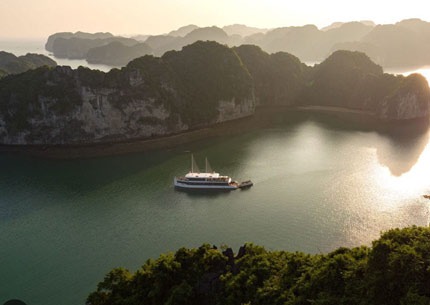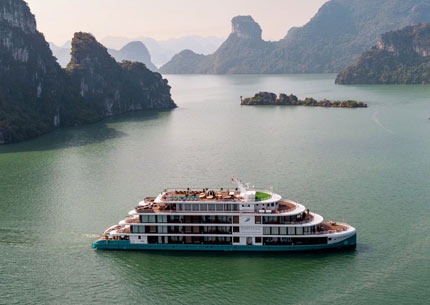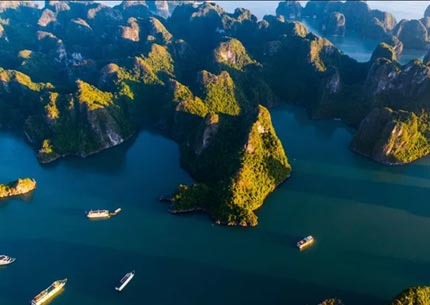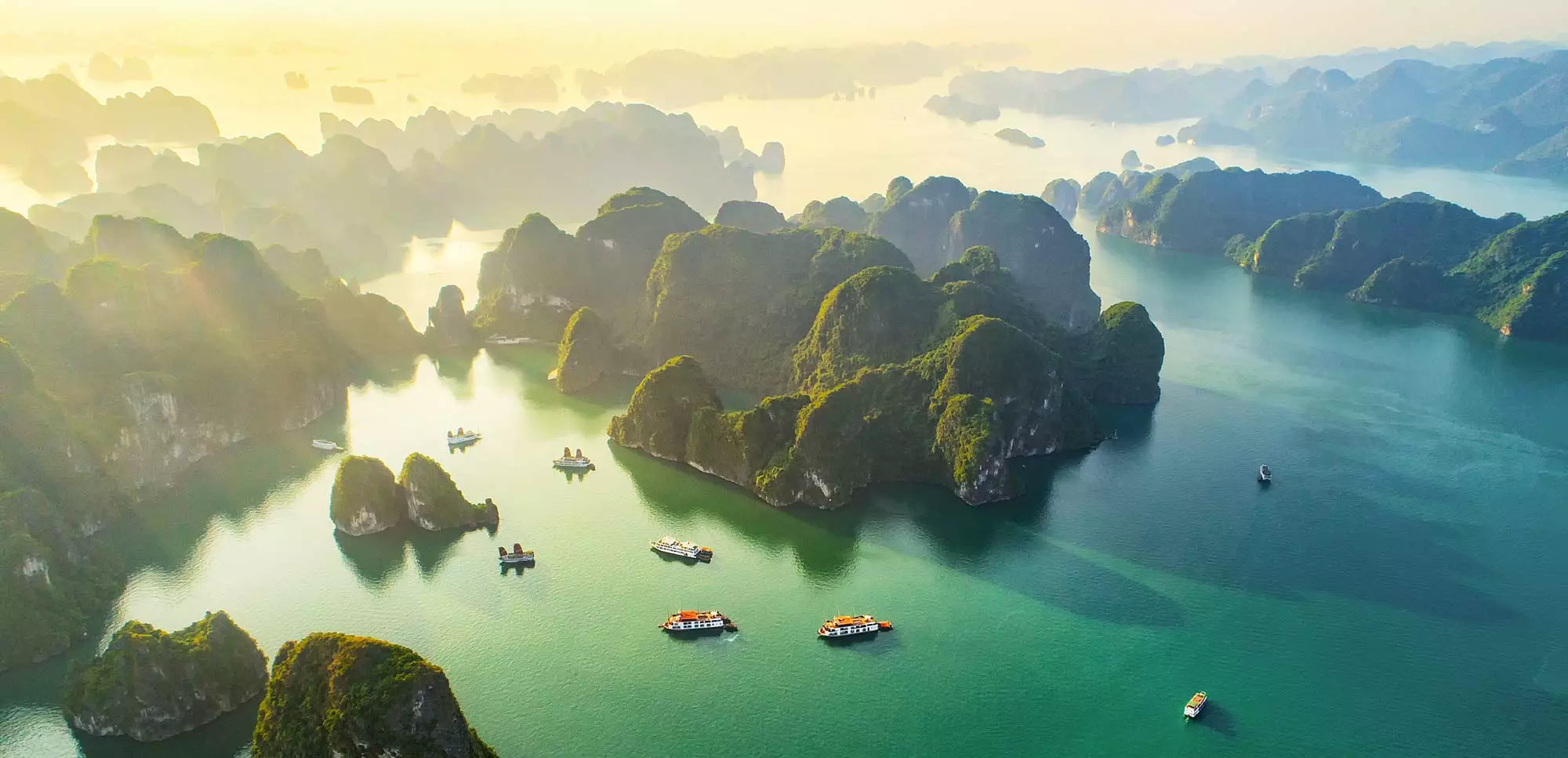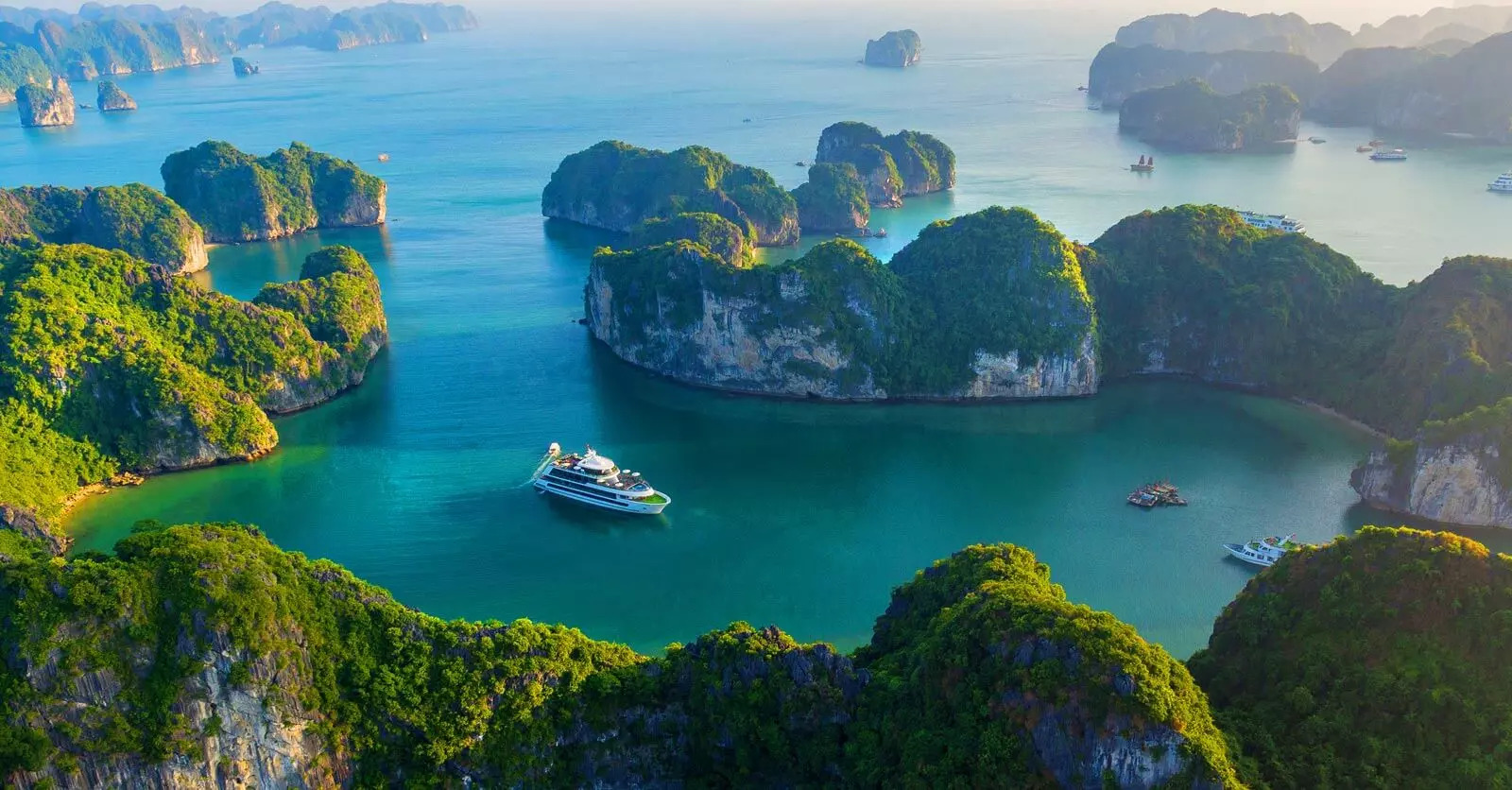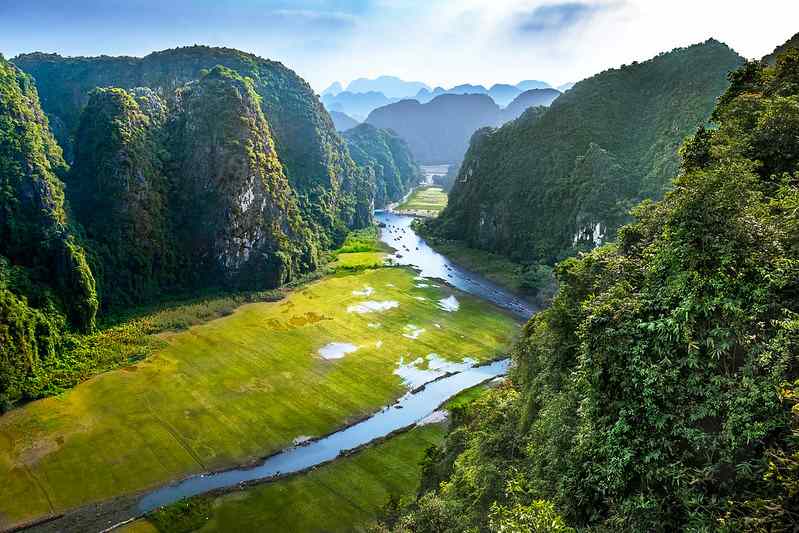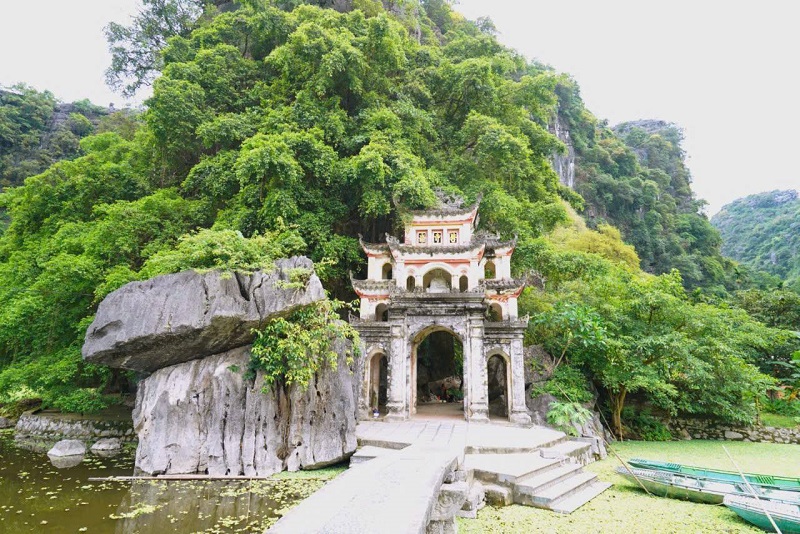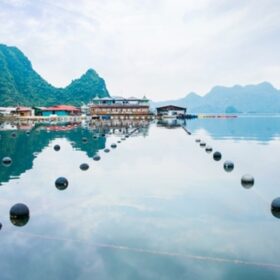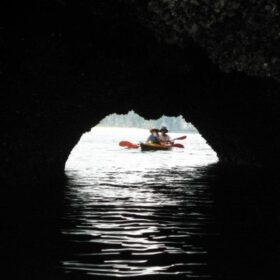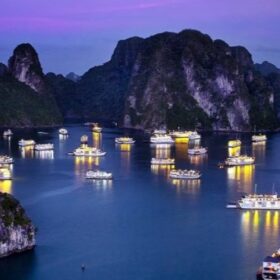21 Fascinating Highlights of Bich Dong Pagoda Ninh Binh: Ultimate 2025-2026 Explorer’s Guide
Embark on a journey through one of Vietnam’s most enchanting spiritual sanctuaries nestled within dramatic limestone landscapes. This comprehensive guide reveals everything you need to know about Bich Dong Pagoda – from its hidden caves to panoramic viewpoints – ensuring an unforgettable experience in Ninh Binh’s emerald paradise.
The Mystical Allure of Bich Dong Pagoda: Vietnam’s Three-Tiered Mountain Temple
Bich Dong Pagoda (Chùa Bích Động) stands as a remarkable testament to Vietnam’s spiritual heritage, seamlessly blending human ingenuity with natural splendor. This ancient complex, whose name translates to “Green Pearl Grotto,” isn’t merely a religious site—it’s a living masterpiece carved into the limestone karsts of Ninh Binh Province.
Dating back to 1428, Bich Dong distinguishes itself through its unique three-level structure that ascends a limestone mountain. Each level represents a different aspect of Buddhist enlightenment: Body (Ha Pagoda), Speech (Trung Pagoda), and Mind (Thuong Pagoda). What makes this sacred site truly exceptional is how it harmonizes with its surroundings—each pagoda seamlessly integrated with natural caves and rock formations.
As part of the UNESCO-recognized Trang An Landscape Complex, Bich Dong offers more than spiritual significance. The panoramic views from its upper levels reveal a breathtaking tapestry of emerald rice fields, winding rivers, and dramatic limestone formations that epitomize the natural beauty that has earned Ninh Binh the nickname “Halong Bay on Land.”
For travelers planning their 2025-2026 Vietnam itinerary, Bich Dong provides a perfect balance of cultural immersion, natural beauty, and spiritual discovery—all within a site that remains relatively uncrowded compared to other major attractions.
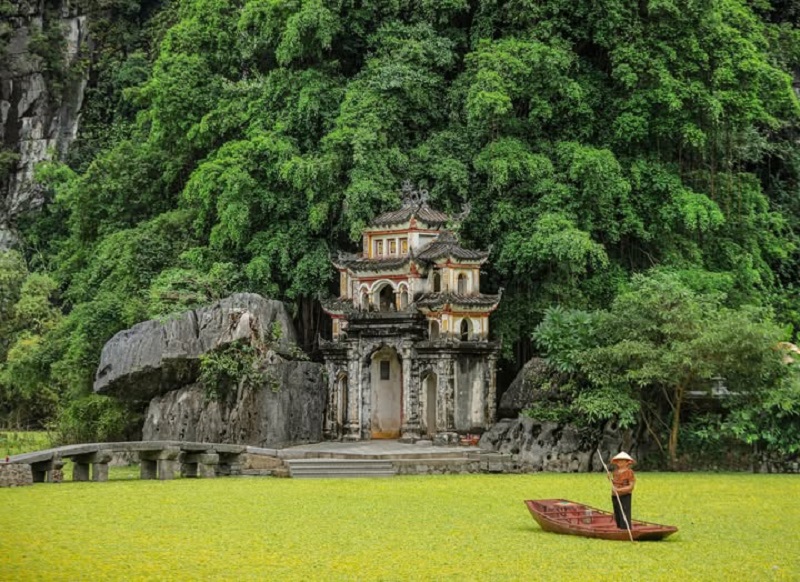
Historical Significance and Spiritual Legacy of Bich Dong
The Ancient Origins of the Three-Level Pagoda
The story of Bich Dong Pagoda began in 1428 during the early Le Dynasty when three Buddhist monks—Tri Kien, Tri The, and Tri Tam—discovered this serene location. Captivated by the natural beauty and peaceful ambiance, they established a meditation retreat that would eventually evolve into today’s magnificent temple complex.
What’s particularly fascinating is that the pagoda wasn’t constructed as a single building project. Instead, it developed organically over centuries, with each generation adding architectural elements that reflected both Buddhist principles and Vietnamese aesthetic sensibilities. The complex reached its architectural zenith during the 18th century when Lord Trinh Sam visited in 1773 and, struck by its beauty, bestowed the name “Bich Dong” (Green Pearl Grotto).
Archaeological studies conducted in 2023 revealed that some of the foundation stones and original cave altars date back even earlier than previously thought, possibly to the 12th century Tran Dynasty period. This makes Bich Dong not just spiritually significant but historically invaluable as a living chronicle of Vietnamese architectural evolution.
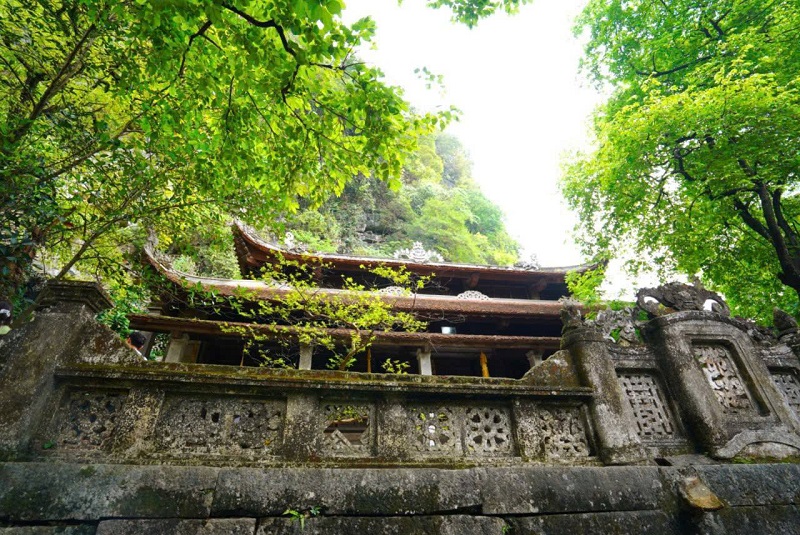
Sacred Sculptures and Religious Artifacts
The pagoda houses an impressive collection of religious artwork that spans multiple centuries. The most noteworthy treasures include:
- 18 Arhat statues: Carved from stone and wood during the 13th-14th century Tran Dynasty, these depict Buddha’s original disciples with remarkable detail and expressiveness.
- Bronze bell: Dating from 1787, this ceremonial bell measures 0.8 meters tall and weighs approximately 100 kg. It still resonates with deep, meditative tones during special ceremonies.
- Ancient stone inscriptions: Located in the cave walls of Trung Pagoda, these calligraphic works include poems praising the natural beauty of the site, with the oldest dating to 1592.
- Wooden altars: Intricately carved during the Later Le Dynasty (17th century), featuring dragon and phoenix motifs that represent Vietnamese imperial aesthetics.
Recent restoration work completed in 2024 has carefully preserved these artifacts while making them more accessible to visitors. Conservation experts from Hanoi have implemented climate-controlled display cases for the most delicate items, ensuring they’ll remain intact for future generations.
Architectural Marvel: The Three-Tiered Pagoda Complex
Ha Pagoda (Lower Level): Gateway to Spirituality
Ha Pagoda serves as the welcoming threshold to Bich Dong’s spiritual journey. Situated at the mountain’s base, this first-level temple creates an immediate impression with its distinctive architectural elements:
- Triple-arched entrance gate: Constructed from locally quarried limestone and dating to the early 18th century, this imposing 7-meter-tall structure features three passages representing the Buddha, the Dharma, and the Sangha.
- Traditional wooden pavilion: The main hall spans 15 × 8 meters and showcases classic Vietnamese temple architecture with its curved, multi-tiered roof supported by 16 cylindrical wooden columns.
- Reflecting lotus pond: A rectangular water feature measuring 12 × 8 meters surrounds the entrance, creating serene reflections of the pagoda while symbolizing purity and enlightenment in Buddhist tradition.
What makes Ha Pagoda particularly special is its strategic positioning. Built on flat ground and oriented to face southeast according to traditional feng shui principles, it captures optimal natural light throughout the day. The pavilion’s elevated foundation sits 1.2 meters above the surrounding landscape, protecting it from seasonal flooding while creating a sense of reverence as visitors ascend the stone steps.
Inside, the central altar houses a 1.8-meter bronze statue of Amitabha Buddha flanked by Bodhisattvas Avalokitesvara and Mahasthamaprapta. These statues, cast in 1765, exhibit remarkable craftsmanship with their serene expressions and detailed hand gestures (mudras) representing compassion and wisdom.
Trung Pagoda (Middle Level): The Cave Sanctuary
After climbing approximately 85 stone steps from Ha Pagoda, visitors reach Trung Pagoda—perhaps the most architecturally unique level of the complex. What distinguishes this middle temple is its seamless integration with a natural limestone cave:
- Semi-cave structure: The front portion consists of a 6 × 4 meter wooden temple structure, while the rear extends 12 meters into the mountain itself, creating a mystical transition between human construction and natural formation.
- Natural stone altar: Unlike conventional temples, the central worship area utilizes naturally formed stalactites and rock formations that have been minimally carved to create altar surfaces for religious statues and offerings.
- Light wells: Three natural openings in the cave ceiling, measuring between 0.5-1.2 meters in diameter, allow shafts of natural light to penetrate the darkness, creating ethereal lighting effects that change throughout the day.
The acoustics within Trung Pagoda are particularly remarkable. The cave’s natural configuration creates resonant properties that amplify chanting and meditation sounds. Scientific analysis conducted in 2023 found that the cave maintains a consistent temperature of 22-24°C (71-75°F) year-round, regardless of external weather conditions, making it an ideal environment for contemplation in all seasons.
Decorative elements include 24 bas-relief carvings depicting scenes from Buddha’s life and Jataka tales (stories of Buddha’s previous lives). These were created during the Nguyen Dynasty period (early 19th century) and showcase a fascinating blend of Vietnamese and Chinese artistic influences.
Thuong Pagoda (Upper Level): Celestial Heights
The final ascent to Thuong Pagoda requires navigating through the mysterious Dark Cave (Hang Toi) and climbing another 60 steep steps. This effort rewards visitors with both spiritual significance and breathtaking vistas:
- Cave passage: The transition between Trung and Thuong levels involves a 15-meter passage through near-complete darkness, symbolizing the journey through ignorance toward enlightenment.
- Summit shrine: The uppermost temple occupies a dramatic position at 78 meters above the valley floor. Though smaller in size (approximately 5 × 4 meters), its elevated location creates an impression of floating among the limestone peaks.
- Panoramic viewing platform: A 24-square-meter stone terrace extends from the temple, offering a 180-degree vista encompassing 7 kilometers of Tam Coc’s landscape, including the meandering Ngo Dong River and patchwork of rice fields.
The architecture of Thuong Pagoda demonstrates remarkable engineering ingenuity. Built on an irregular natural platform, its wooden structure incorporates a system of support beams anchored directly into the limestone. Recent reinforcement work completed in 2024 has strengthened these historic supports while preserving their original design.
Inside this highest sanctuary, a central altar houses a meditation-posed Buddha carved from a single block of limestone, estimated to weigh 800 kg. According to local tradition, this statue was transported to the summit in 1707—an extraordinary feat given the challenging access route and technology available at that time.
Natural Surroundings and Breathtaking Landscapes
Limestone Karst Geology of Bich Dong
Bich Dong Pagoda’s dramatic setting within Ninh Binh’s karst landscape represents one of Vietnam’s most distinctive geological environments. The temple complex is nestled within the Trang An Landscape Complex, which features:
- Tower karst formations: Surrounding the pagoda are dramatic limestone peaks rising 50-200 meters above the valley floor. These formations began developing approximately 250 million years ago when the region was a shallow sea, gradually forming through calcium carbonate deposition and subsequent erosion.
- Cave systems: Beyond the three main caves incorporated into the pagoda structure, the surrounding mountain contains at least 17 additional caverns and passages, some extending more than 300 meters into the limestone.
- Natural springs: The area features several freshwater springs emerging from the karst, including one near Ha Pagoda that produces approximately 15 liters per minute of mineral-rich water that local residents consider to have healing properties.
Geological surveys conducted in 2024 identified Bich Dong’s limestone as primarily composed of calcite (95%) with traces of dolomite and quartz. Carbon dating of stalactites within the pagoda’s caves indicates continuous formation over the past 35,000 years, with growth rates averaging 0.08 mm per year.
The distinctive weathering patterns visible on the exterior rock faces—deep vertical grooves and honeycombed surfaces—result from centuries of rainfall dissolution, creating what geologists term “lapies” or “karrenfeld” formations that give the mountains their textured appearance.
Flora and Fauna Around the Temple Complex
The ecological environment surrounding Bich Dong creates a natural sanctuary that enhances the spiritual atmosphere of the pagoda:
- Native vegetation: The limestone slopes support a specialized ecosystem of drought-resistant plants, including 37 species of ferns, 12 varieties of orchids, and several endemic succulents that have adapted to the minimal soil conditions. The bright green Cycas balansae (a primitive cycad species) growing from seemingly bare rock faces is particularly striking.
- Birdlife diversity: Ornithological surveys in 2023 identified 58 bird species in the immediate vicinity, including the endangered black-faced spoonbill and the colorful red-whiskered bulbul. Dawn visitors may observe kingfishers diving into the lotus ponds near Ha Pagoda.
- Primate residents: A small population of approximately 35 Delacour’s langurs—one of the world’s rarest primates—inhabits the karst mountains surrounding Bich Dong. These endangered monkeys, with their distinctive black and white coloration, can occasionally be spotted in the early morning or late afternoon.
The seasonal transformation of the landscape creates dramatically different experiences throughout the year. During the May-September wet season, lush vegetation covers the limestone, while the October-April dry period reveals more of the dramatic rock formations. The rice paddies surrounding the pagoda cycle through vibrant green (planting season), golden yellow (harvest time), and reflective water surfaces (flooding periods).
Conservation efforts implemented in 2024 include designated viewing areas to minimize human impact on sensitive habitats and educational signage identifying notable species. These measures aim to balance tourism with environmental protection, ensuring the natural character of Bich Dong remains intact.
Planning Your Visit to Bich Dong Pagoda in 2025-2026
Practical Information for Travelers
Visiting Bich Dong Pagoda requires some advance planning to ensure a smooth and enjoyable experience. Here’s the essential information for 2025 travelers:
- Location: Ngu Nhac Son Mountain, Dam Khe Village, Ninh Hai Commune, Hoa Lu District, Ninh Binh Province, Vietnam
- GPS Coordinates: 20.2545° N, 105.8639° E
- Opening Hours: 7:00 AM to 6:00 PM daily (extended to 7:00 PM during summer months)
- Entrance Fee: Free admission to the pagoda complex
- Parking: Available for motorcycles (5,000 VND) and cars (20,000 VND) in a designated 2,000-square-meter lot 150 meters from the entrance
- Average Visit Duration: 1.5-2 hours to fully explore all three levels
- Visitor Facilities: Public restrooms available near the entrance; several rest areas with seating throughout the complex; a visitor information center opened in late 2024 provides multilingual brochures
For those with mobility concerns, it’s important to note that while Ha Pagoda is accessible to most visitors, reaching Trung and Thuong Pagodas requires climbing steep, uneven stone steps—approximately 145 steps in total to reach the highest point. Handrails have been installed along most sections as of a 2024 safety upgrade, but comfortable walking shoes are essential.
Photographers should note that the most favorable lighting conditions occur between 8:00-10:00 AM when morning light illuminates the cave interiors, and from 3:00-5:00 PM when the golden afternoon sun creates dramatic shadows across the limestone formations.
Best Times to Visit and Seasonal Considerations
The experience of Bich Dong varies significantly throughout the year, with each season offering distinct advantages:
- March to May (Spring): Perhaps the most photogenic period with moderate temperatures (20-28°C/68-82°F) and blooming vegetation. The surrounding rice fields transition from water-filled reflective surfaces to tender green shoots, creating picturesque landscapes. Visitor numbers are moderate, averaging 600-800 daily.
- June to August (Summer): The hottest period (30-35°C/86-95°F) with occasional afternoon thunderstorms. The lush, mature rice paddies create vibrant green panoramas. The cave interiors provide natural cooling, maintaining temperatures around 23°C/73°F even on the hottest days. This is high season, with daily visitor counts often exceeding 1,200.
- September to November (Autumn): Considered by many to be the ideal time to visit, with comfortable temperatures (22-28°C/72-82°F), reduced humidity, and golden rice fields ready for harvest. The autumn light creates particularly striking photographic opportunities, especially from Thuong Pagoda’s viewing platform. Visitor numbers begin decreasing to 500-700 daily.
- December to February (Winter): The coolest months (15-20°C/59-68°F) with occasional misty mornings creating ethereal landscapes. The bare rice fields reveal more of the limestone karst features. This is low season with the fewest visitors (300-400 daily), offering a more contemplative experience.
For 2025, be aware that Tet (Vietnamese Lunar New Year) falls between January 29 and February 4, during which time the pagoda will host special ceremonies and see increased domestic tourism. The site may be particularly crowded during this period, but visitors can witness traditional Buddhist rituals and festive decorations.
The annual Bich Dong Festival, scheduled for March 15-17, 2025, features traditional performances, ritual ceremonies, and local crafts displays. While this creates a culturally rich experience, expect significantly higher visitor numbers during these dates.
Transportation Options and Accessibility
Reaching Bich Dong Pagoda has become increasingly convenient in 2025-2026, with several transportation options available:
- From Hanoi: The 100-kilometer journey takes approximately 2 hours via the upgraded CT03 expressway. Regular limousine buses depart from Giap Bat station (120,000 VND one-way), while private car services offer direct transfers (around 1,200,000 VND each way).
- From Ninh Binh City: Located just 12 kilometers southwest, taxis charge approximately 150,000-200,000 VND for the 20-minute journey. The new electric shuttle service (50,000 VND) operates hourly from Ninh Binh railway station between 8:00 AM and 4:00 PM.
- From Tam Coc: Being only 2 kilometers away, Bich Dong is easily accessible from Tam Coc by bicycle rental (40,000 VND/day), electric golf cart (70,000 VND one-way), or a pleasant 25-minute walk along a scenic country road.
For those seeking convenience, several comprehensive tour packages combine Bich Dong with other Ninh Binh highlights and even extend to Halong Bay for a complete North Vietnam experience. These organized tours handle all transportation logistics while providing knowledgeable guides who enhance the cultural understanding of these sites.
Independent travelers with limited time should consider the efficient 2-day, 1-night Ninh Binh to Halong Bay tour, which includes Bich Dong in its itinerary. This option maximizes sightseeing while minimizing transit time between these two iconic destinations.
Within the pagoda complex itself, the path to Ha Pagoda is wheelchair accessible via a recently constructed 1.2-meter-wide paved walkway. However, the upper levels remain accessible only via stone staircases. The visitor center can arrange assistance for those with mobility challenges who wish to view photographs and video presentations of the upper levels.
Cultural Immersion and Spiritual Experience
Buddhist Rituals and Religious Practices
Bich Dong Pagoda continues to function as an active religious site, offering visitors glimpses into authentic Buddhist practices that have continued for centuries:
- Daily Ceremonies: Resident monks perform morning chanting at 5:30 AM and evening prayers at 5:00 PM. Visitors are welcome to observe these rituals from designated areas at the side of the main halls, providing an authentic glimpse into Vietnamese Buddhist practices.
- Meditation Sessions: The pagoda hosts guided meditation sessions in the cave of Trung Pagoda every Tuesday and Thursday at 3:00 PM. These 30-minute sessions are conducted in both Vietnamese and English, allowing visitors to experience firsthand the spiritual purpose of these sacred spaces.
- Incense Offerings: Visitors can participate in the tradition of offering incense at each level of the pagoda. Incense sticks are available for purchase (20,000 VND for a bundle) at small stalls near the entrance, with proceeds supporting the pagoda’s maintenance.
The most significant ceremony of the year occurs during the first full moon of the lunar calendar (typically February), when the pagoda hosts an elaborate Buddha Bathing Ceremony. During this ritual, statues of Buddha are ceremonially cleansed with scented water, symbolizing the purification of body and mind. In 2025, this ceremony is scheduled for February 12 and will feature traditional music performances and a procession of monks carrying lanterns through the cave passages.
Etiquette and Respectful Behavior for Visitors
Visiting Bich Dong as a culturally respectful traveler enhances both your experience and preserves the site’s spiritual integrity. Visitors should observe these guidelines:
- Dress Code: Modest attire is required—shoulders and knees should be covered when entering temple buildings. Sarongs are available to borrow at the entrance for those in shorts or sleeveless tops.
- Photography Protocol: Photography is permitted in most areas, but flash photography is prohibited inside the cave temples to preserve the ancient paintings and create minimal disturbance during prayers. Tripods require special permission available at the visitor center.
- Sacred Objects: Refrain from touching statues, altars, or religious artifacts. When offering incense, use your right hand or both hands as a sign of respect.
- Noise Consideration: Maintain a respectful volume, particularly when monks are performing ceremonies or when other visitors are meditating. Guided tours should use whisper systems rather than loud explanations inside temple areas.
- Right-to-Left Movement: Follow the traditional clockwise direction when circling stupas or altar areas, moving from right to left as a sign of respect in Buddhist practice.
The pagoda administrators have introduced subtle guidance systems in 2024, including small informational signs in English, Vietnamese, Korean, and Chinese explaining specific customs. These efforts aim to enhance cultural understanding while maintaining the authentic spiritual atmosphere of this working religious site.
Comprehensive Itinerary Planning
One-Day Itinerary: Bich Dong and Surroundings
For travelers with a single day to explore Bich Dong and its surroundings, this carefully crafted itinerary maximizes your experience while avoiding the most crowded periods:
7:30 AM – 8:00 AM: Arrival and Morning Light
Begin your day early to experience Bich Dong in the magical morning light. Park at the main lot and enjoy the short walk to the entrance, passing local vendors setting up for the day. Morning mist often lingers among the limestone peaks at this hour, creating ethereal photo opportunities.
8:00 AM – 9:30 AM: Explore the Three-Tiered Pagoda
Start your exploration at Ha Pagoda, then gradually ascend to Trung and Thuong levels. This timing allows you to experience the complex before larger tour groups arrive, providing a more contemplative atmosphere. The morning light beautifully illuminates the cave interiors at this hour.
9:30 AM – 11:00 AM: Tam Coc Boat Ride
Head to nearby Tam Coc (just 2 km away) for a sampan boat ride through the “Three Caves” along the Ngo Dong River. The 1.5-hour journey takes you through limestone caves and past rice fields. Morning departures are recommended to avoid midday heat.
11:00 AM – 12:30 PM: Local Lunch Experience
Enjoy authentic Ninh Binh cuisine at Thuy Linh Restaurant, located 800 meters from the Tam Coc boat dock. Their specialties include “cơm cháy” (crispy rice with mountain goat meat) and “ốc luộc” (boiled snails with lemongrass). A typical meal costs 150,000-200,000 VND per person.
12:30 PM – 2:30 PM: Hang Mua Peak Climb
Visit Hang Mua, 5 km from Tam Coc. Climb the 500 steps to the summit for panoramic views over the entire region. The midday light reveals the full landscape, with visibility extending up to 15 km on clear days. The climb takes 20-30 minutes depending on fitness level.
2:30 PM – 4:00 PM: Hoa Lu Ancient Capital
Explore Vietnam’s first capital at Hoa Lu, 10 km from Hang Mua. Visit the temples dedicated to emperors Dinh Tien Hoang and Le Dai Hanh, with structures dating back to the 10th century. The site covers 300 hectares, though most visitors focus on the central 3-hectare temple complex.
4:00 PM – 5:30 PM: Return to Bich Dong for Sunset
Return to Bich Dong for a different perspective as the afternoon light casts long shadows across the landscape. The upper level offers particularly stunning sunset views as the limestone karsts are bathed in golden light. This timing also avoids the midday crowds.
Evening Option: Van Long Nature Reserve Sunset Boat Tour
For those with energy remaining, add a 5:30 PM – 7:00 PM boat tour at Van Long Nature Reserve (15 km from Bich Dong). This peaceful wetland area offers opportunities to spot endangered Delacour’s langurs and various bird species during their most active evening hours.
Multi-Day Exploration: Ninh Binh and Beyond
For travelers with more time, Bich Dong serves as an excellent anchor point for a comprehensive exploration of Ninh Binh Province and beyond. This expanded itinerary offers an immersive experience across 3 days:
Day1: Tam Coc Area Focus
- Morning: Bich Dong Pagoda exploration (2.5 hours)
- Midday: Tam Coc boat ride (1.5 hours)
- Afternoon: Cycling through rice fields on a 12-kilometer route passing Thai Vi Temple and local villages
- Evening: Traditional music performance at a cultural house in Tam Coc
Day 2: Expanded Ninh Binh Highlights
- Morning: Trang An Grottoes UNESCO site boat tour, covering 12 kilometers and passing through 9 different caves
- Midday: Lunch and visit to Bai Dinh Pagoda, Vietnam’s largest Buddhist complex
- Afternoon: Hoa Lu Ancient Capital and Hang Mua Peak
- Evening: Specialized food tour featuring unique Ninh Binh delicacies
Day3: Connect to Halong Bay
- Morning: Van Long Nature Reserve for wildlife spotting
- Midday: Departure for Halong Bay (3-hour drive)
- Afternoon: Board a luxury cruise in Halong Bay
- Evening: Overnight on the emerald waters among thousands of limestone islands
This multi-day approach allows travelers to experience the complete limestone landscape continuum from Ninh Binh to Halong Bay, showcasing how these UNESCO sites form part of the same geological system despite their different presentations—one surrounded by rice fields, the other by ocean waters.
For convenience and seamless logistics, the comprehensive 3-day Ninh Binh to Halong Bay package offered by Halong Bay Lux Cruises handles all transportation, accommodations, and guided experiences. This professionally organized tour ensures you experience these destinations with expert commentary while avoiding the complexities of independent travel in rural Vietnam.
Photography Tips and Best Viewpoints
Capturing Bich Dong’s Timeless Beauty
Bich Dong Pagoda offers exceptional photography opportunities that blend architecture, nature, and spiritual elements. Here are specialized tips for photographers visiting in 2025:
Best Camera Settings and Equipment:
- Cave Interiors: Use a wide-angle lens (16-24mm) with a large aperture (f/2.8-4) to capture the atmospheric temple caves. Set ISO between 800-1600 and consider bracketing exposures to handle the challenging contrast between dark interiors and bright entrance areas.
- Landscape Views: From Thuong Pagoda, a 24-70mm zoom provides versatility for both detailed architectural shots and wider landscapes. A polarizing filter reduces glare from rice fields and enhances cloud detail.
- Essential Accessories: Bring a lightweight tripod for low-light cave photography and long-exposure water shots in the lotus ponds. A remote shutter release helps with stability during longer exposures.
Signature Shots and Locations:
- Triple Gate Reflection: Position yourself 10 meters back from the lotus pond in front of Ha Pagoda to capture the reflection of the triple-arched entrance gate in still water. Best photographed before 9:00 AM when the water surface remains undisturbed by wind.
- Light Beams in Trung Pagoda: During mid-morning (9:30-11:00 AM), sunlight filters through the natural ceiling openings in Trung Pagoda, creating dramatic light beams through the incense smoke. Position yourself facing the altar with light coming from behind it.
- Stairway to Enlightenment: The stone staircase leading from Trung to Thuong Pagoda offers a compelling compositional element, especially when framed by the surrounding foliage. Shoot from the bottom looking up to emphasize the journey aspect.
- Panoramic Vista: From Thuong Pagoda’s viewing platform, capture a 180-degree panoramic stitched image encompassing the full Tam Coc landscape. Most effective in late afternoon when shadows add depth to the limestone formations.
- Monks in Context: With respectful distance and permission, photographs of monks performing daily activities against the backdrop of ancient architecture create powerful cultural documentations. Morning and evening ceremonies offer the most authentic opportunities.
Seasonal Photographic Highlights
Each season transforms Bich Dong’s appearance, offering photographers distinct creative opportunities:
Spring (March-May):
- Capture misty mornings with ethereal light filtering through new foliage
- Focus on the contrasting textures between ancient stone and fresh spring blooms
- The water levels in rice fields create mirror-like reflections of the limestone mountains
Summer (June-August):
- Dramatic cloud formations provide dynamic skies as backgrounds
- Lush, vibrant green rice paddies reach their peak saturation
- Summer rain creates temporary waterfalls down the limestone surfaces
Autumn (September-November):
- Golden light bathes the yellowing rice fields during harvest season
- Clearer atmospherics allow for sharper long-distance landscape shots
- The lower sun angle creates longer, more dramatic shadows across the pagoda structures
Winter (December-February):
- Morning mist creates a mystical atmosphere among the bare limestone peaks
- The more minimalist landscape reveals the stark architectural details of the pagoda
- Occasional light frost creates rare and striking compositions
Photography workshops led by local experts are available twice monthly in 2025 (schedule available at the visitor center), providing specialized guidance on capturing Bich Dong’s ever-changing moods while respecting its spiritual significance.
Culinary Experiences and Local Specialties
Traditional Ninh Binh Cuisine Near Bich Dong
The area surrounding Bich Dong Pagoda offers a distinctive culinary landscape that reflects the region’s agricultural heritage and natural resources. Visitors can enhance their cultural immersion through these authentic food experiences:
Signature Regional Dishes:
- Mountain Goat (Dê Núi): The limestone mountains of Ninh Binh support herds of free-range goats, resulting in exceptionally tender and flavorful meat. Try it prepared seven different ways at Nhà Hàng Dê Núi Ninh Bình, located 1.2 km from Bich Dong. Their signature “dê nướng” (grilled goat with lime leaves and galangal) costs 220,000 VND per portion.
- Com Cháy (Crispy Rice): This ingenious dish transforms leftover rice into crispy golden cakes topped with savory mountain goat or pork. Thuy Linh Restaurant perfects this local specialty, serving it with a tangy fish sauce reduction for 85,000 VND.
- Ốc Luộc (Boiled Snails): Harvested from the rice fields surrounding Bich Dong, these freshwater snails are boiled with lemongrass, ginger, and citrus leaves. Extracted with small picks and dipped in a chili-lime sauce, they’re a popular appetizer at most local eateries, costing 70,000-90,000 VND per plate.
- Cơm Niêu (Clay Pot Rice): Rice cooked in traditional clay pots absorbs a distinctive smoky flavor. Family Kitchen (Bếp Gia Đình), a 10-minute walk from Bich Dong’s entrance, serves this with seasonal vegetables and river fish for 120,000 VND per person.
Local Dining Recommendations:
-
Thuy Linh Restaurant
- Location: 800 meters from Tam Coc boat dock (10-minute drive from Bich Dong)
- Specialties: Complete mountain goat menu, field crab soup, and clay pot fish
- Price range: 150,000-250,000 VND per person
- Ambiance: Open-air dining with views of limestone mountains
-
Chợ Quê Restaurant (Countryside Market)
- Location: 1.5 km from Bich Dong entrance
- Specialties: Authentic rural cuisine including bamboo-tube rice and grilled field fish
- Price range: 120,000-200,000 VND per person
- Distinctive feature: Food prepared using traditional cooking methods visible to diners
-
Anh Dzung Homestay & Restaurant
- Location: 2 km from Bich Dong (direction of Tam Coc)
- Specialties: Home-style Vietnamese cooking with vegetables from their garden
- Price range: 100,000-180,000 VND per person
- Bonus: Cooking classes available with advance booking (350,000 VND for 3-hour session)
For those with dietary restrictions, Hương Sen Vegetarian Restaurant, located 3 km from Bich Dong, offers creative plant-based interpretations of local specialties, with most dishes priced between 60,000-100,000 VND.
Food Tours and Cooking Classes
Several operators now offer specialized culinary experiences that connect the region’s food traditions with its cultural heritage:
Taste of Ninh Binh Food Tour:
- 4-hour guided exploration of local markets and food vendors
- Includes transportation from major Ninh Binh hotels
- 8 different food stops featuring 15+ regional specialties
- Knowledgeable guides explain the historical and agricultural context of each dish
- Cost: 850,000 VND per person (minimum 2 participants)
Countryside Cooking Experience:
- Half-day immersion in traditional Vietnamese cooking techniques
- Begins with market tour to select fresh ingredients
- Hands-on preparation of 4 authentic Ninh Binh dishes
- Meal enjoyed in a garden setting with rice field views
- Includes recipe booklet to recreate dishes at home
- Cost: 650,000 VND per person (available daily with advance booking)
For a truly unique experience, the “Rice Field to Table” program takes participants through the entire food production process—from helping local farmers in the paddies surrounding Bich Dong to preparing a meal with the harvested ingredients. This full-day experience (1,200,000 VND) offers profound insights into rural Vietnamese life and food traditions.
Accommodation Options for Every Budget
Where to Stay Near Bich Dong Pagoda
Ninh Binh’s growing tourism industry has developed diverse accommodation options catering to all preferences and budgets. Here are the best places to stay when visiting Bich Dong Pagoda in 2025:
Luxury Retreats (Above $150/night):
-
Tam Coc Garden Resort
- Distance from Bich Dong: 2.8 km (5-minute drive)
- Accommodation type: Luxury bungalows built in traditional Vietnamese architectural style
- Amenities: Infinity pool overlooking limestone mountains, spa treatments, organic garden restaurant
- Room sizes: 45-90 square meters
- Notable feature: Each bungalow offers private terraces with panoramic mountain views
- Price range: $180-320 per night
- Perfect for: Couples seeking romantic seclusion and natural beauty
-
Emeralda Ninh Binh Resort & Spa
- Distance from Bich Dong: 15 km (25-minute drive)
- Accommodation type: Expansive luxury resort with Vietnamese village-inspired design
- Amenities: Three swimming pools, full-service spa, three restaurants, tennis courts
- Room sizes: 60-120 square meters
- Notable feature: 16-hectare property with extensive gardens and rice paddies
- Price range: $150-280 per night
- Perfect for: Families and travelers seeking comprehensive resort facilities
Mid-Range Comfort ($50-150/night):
- Tam Coc Rice Fields Resort
- Distance from Bich Dong: 1.5 km (20-minute walk)
- Accommodation type: Modern rooms and bungalows integrated with natural surroundings
- Amenities: Outdoor pool, bicycle rentals, restaurant serving local specialties
- Room sizes: 32-48 square meters
- Notable feature: Rooms with floor-to-ceiling windows framing limestone mountain views
- Price range: $70-130 per night
- Perfect for: Independent travelers seeking convenience to multiple attractions
- Ninh Binh Hidden Charm Hotel
- Distance from Bich Dong: 10 km (15-minute drive)
- Accommodation type: Contemporary hotel with traditional Vietnamese accents
- Amenities: Rooftop pool, spa services, restaurant, tour desk
- Room sizes: 30-45 square meters
- Notable feature: Centrally located for exploring both Tam Coc and Trang An areas
- Price range: $60-110 per night
- Perfect for: Travelers seeking modern amenities with easy access to main tourist sites
Budget-Friendly Options (Under $50/night):
-
Tam Coc Bungalow Homestay
- Distance from Bich Dong: 2.3 km (30-minute walk or 5-minute drive)
- Accommodation type: Family-run homestay with private rooms
- Amenities: Home-cooked breakfasts, bicycle rentals, communal garden
- Room sizes: 18-25 square meters
- Notable feature: Authentic local experience with attentive family hosts
- Price range: $25-45 per night
- Perfect for: Budget travelers seeking cultural immersion
-
Nguyen Shack Ninh Binh
- Distance from Bich Dong: 4 km (10-minute drive)
- Accommodation type: Eco-friendly bamboo bungalows
- Amenities: Vegetarian restaurant, free kayaks, hammocks throughout property
- Room sizes: 15-30 square meters
- Notable feature: Unique bamboo architecture in a wetland setting
- Price range: $30-50 per night
- Perfect for: Eco-conscious travelers and nature enthusiasts
Special Accommodation Experiences
For travelers seeking distinctive overnight experiences that enhance their connection to Ninh Binh’s natural and cultural landscape:
Floating Homestays:
Several accommodations near Tam Coc now offer overwater bungalows built on stilts above the rice fields. During planting season when fields are flooded, these create the illusion of floating on water. Tam Coc Wonderful Homestay (3 km from Bich Dong) offers these unique rooms from $65 per night, including breakfast and free bicycle use.
Farm Stay Experiences:
Immerse yourself in rural Vietnamese life at Ninh Binh Farm Stay (5 km from Bich Dong). This working farm allows guests to participate in rice cultivation, water buffalo tending, and vegetable harvesting. Traditional mud-brick bungalows with modern amenities start at $40 per night, including all farm activities and home-cooked meals using farm-fresh ingredients.
Temple Stay Program:
For those seeking spiritual dimensions to their journey, a limited temple stay program is available at Bai Dinh Pagoda (18 km from Bich Dong). This overnight experience includes basic accommodations within the temple grounds, participation in morning meditation, and early access to the temple before public opening hours. The program costs 1,200,000 VND per person and requires advance reservation at least 7 days prior.
Beyond Bich Dong: Complete Ninh Binh Experience
Must-Visit Attractions in Ninh Binh Province
While Bich Dong Pagoda is a highlight, Ninh Binh Province offers numerous other exceptional attractions that complement your visit:
-
Trang An Landscape Complex
- UNESCO Status: Designated World Heritage Site in 2014
- Distance from Bich Dong: 12 km (20-minute drive)
- Experience: 2-3 hour boat journey through a network of 48 caves and 31 valleys
- Distinctive Feature: Boat rowers use their feet to navigate through narrow cave passages
- Cultural Significance: Contains archaeological evidence of human activity dating back 30,000 years
- 2025 Enhancement: New eco-friendly electric boats now available for reduced environmental impact
-
Hang Mua Peak (Mua Caves)
- Distance from Bich Dong: 5 km (10-minute drive)
- Experience: Climb 500 stone steps to panoramic viewpoint
- Elevation: 200 meters above the valley floor
- Distinctive Feature: Dragon sculpture winding along the mountain ridge
- Viewpoint Coverage: 360-degree vista encompassing Tam Coc, Trang An, and Ninh Binh city
- Best Timing: Sunrise or sunset for dramatic lighting across the landscape
-
Bai Dinh Pagoda Complex
- Distance from Bich Dong: 18 km (30-minute drive)
- Size: Largest Buddhist complex in Vietnam, covering 539 hectares
- Features: 500 Arhat statues, 3 bronze Buddha statues (including Vietnam’s largest at 10 meters tall)
- Architecture: Blend of traditional Vietnamese and contemporary Buddhist design
- Visitor Experience: Electric shuttle service available to navigate the extensive grounds
- Spiritual Significance: Important pilgrimage site during Buddhist festivals
-
Cuc Phuong National Park
- Distance from Bich Dong: 45 km (1-hour drive)
- Ecosystem: Vietnam’s first national park and important biodiversity hotspot
- Size: 22,200 hectares of tropical rainforest
- Wildlife: Home to 97 mammal species, 300 bird species, and 400 butterfly species
- Highlights: Ancient tree trail (trees over 1,000 years old), Endangered Primate Rescue Center
- Activities: Guided night wildlife spotting tours available (advance booking required)
-
Van Long Nature Reserve
- Distance from Bich Dong: 15 km (25-minute drive)
- Ecosystem: Largest wetland nature reserve in Northern Vietnam
- Wildlife Viewing: Best place to observe endangered Delacour’s langur monkeys in their natural habitat
- Experience: 90-minute sampan boat ride through reed-lined waterways
- Bird Species: Over 100 documented species, including the rare black-faced spoonbill
- 2025 Update: New elevated boardwalk allows for self-guided exploration of certain areas
Cultural and Historical Context of the Region
Ninh Binh’s rich historical significance adds depth to any visit to Bich Dong Pagoda:
Ancient Capital Legacy:
Hoa Lu served as Vietnam’s first permanent capital from 968-1010 CE during the Dinh and Early Le Dynasties. This historical significance is reflected in the traditional architecture throughout the region, including Bich Dong’s design elements. The nearby Hoa Lu Ancient Capital preserves temples dedicated to the founding emperors, with architectural styles that influenced later religious buildings like Bich Dong.
Rice Cultivation Heritage:
The distinctive landscape surrounding Bich Dong—rice fields framed by limestone mountains—represents an agricultural tradition dating back over 2,000 years. The region’s irrigation systems demonstrate sophisticated water management techniques developed through centuries of rice cultivation. This agricultural heritage shapes local cuisine, festivals, and daily life, providing cultural context for visitors to Bich Dong.
Film Location Significance:
Ninh Binh’s dramatic landscapes have attracted international filmmakers, most notably serving as a filming location for “Kong: Skull Island” (2017). Several scenes were filmed within 5 kilometers of Bich Dong Pagoda. This cinematic connection has brought increased attention to the region’s natural beauty and contributed to conservation efforts as authorities recognized the tourism potential of preserving these landscapes.
Strategic Military History:
The limestone caves in the region, including those incorporated into Bich Dong Pagoda, served as shelters and strategic bases during various conflicts throughout Vietnamese history. During the American War (Vietnam War), some caves in the vicinity functioned as storage facilities and meeting places for resistance forces. This defensive aspect explains some of the pagoda’s architectural choices and remote positioning.
Understanding these cultural and historical dimensions enhances appreciation of Bich Dong not as an isolated attraction but as part of a continuous cultural landscape that has shaped Vietnamese identity for centuries.
Personal Stories and Traveler Experiences
Memorable Moments at Bich Dong
The magic of Bich Dong often reveals itself through personal encounters and unexpected moments. Here are authentic experiences shared by recent visitors:
Sunrise Meditation with a Monk
Sarah K., Canada (visited April 2024)
“I arrived at Bich Dong just after sunrise, thinking I’d be alone for photos. As I reached Trung Pagoda, I noticed an elderly monk sitting in meditation near the cave entrance. He gestured for me to join him, and though we shared no common language, we sat in silence for nearly 30 minutes as the morning light gradually filled the cave. The experience was profoundly moving—the centuries-old stones, the gentle sound of dripping water, and the monk’s peaceful presence created a moment of connection I’ll never forget.”
The Hidden Chamber Discovery
Miguel R., Spain (visited October 2024)
“During my visit to Thuong Pagoda, I noticed a small opening in the rock wall that seemed to lead further into the mountain. My curiosity led me to ask a local guide about it. He explained it was a meditation chamber used by monks seeking complete solitude, accessible only through a narrow passage. With permission from the pagoda caretaker, he showed me this hidden space—a perfectly quiet chamber where sound from outside completely disappeared. The guide mentioned that such chambers exist throughout Vietnam’s cave pagodas but are rarely shown to visitors. It felt like glimpsing a secret aspect of Buddhist practice.”
Unexpected Festival Encounter
Akiko T., Japan (visited February 2024)
“I hadn’t planned to visit during any special event, but my trip coincided with a local Buddhist festival celebrating the first full moon of the lunar year. Bich Dong was transformed with hundreds of lanterns illuminating the path from Ha to Thuong Pagoda. Local families shared traditional rice cakes with visitors, and monks performed chanting ceremonies that echoed through the caves. What struck me most was how the pagoda seemed to come alive with its original purpose—not as a tourist site but as a living center of community spiritual life.”
Tips from Experienced Travelers
Seasoned visitors to Bich Dong offer these practical insights for making the most of your experience:
Photography Timing
David W., Professional Photographer
“The lighting at Bich Dong changes dramatically throughout the day. For photographers, there are three prime times: 7:30-8:30 AM when morning light illuminates the entrance to Trung Pagoda with a golden glow; 11:00 AM-noon when sunlight penetrates through ceiling openings in the cave temples creating dramatic light shafts; and 4:30-5:30 PM when the low afternoon sun bathes the limestone in warm tones. I’d recommend planning multiple visits if possible, as each lighting condition reveals different aspects of the pagoda’s beauty.”
Avoiding Crowds
Lin C., Travel Blogger
“Most tour buses arrive between 10:00 AM and 2:00 PM, making this the most crowded period. For a more contemplative experience, arrive before 9:00 AM or after 3:00 PM. Another strategy is to visit on weekdays rather than weekends, which significantly reduces visitor numbers. The most peaceful time I’ve experienced was a Monday morning in November—I had Thuong Pagoda completely to myself for almost an hour.”
Connecting with Local Culture
Elena V., Cultural Anthropologist
“Take time to observe the local offerings at the altars—these provide insight into Vietnamese spiritual practices. Fresh fruit, flowers, and incense are common, but you might also notice personal items like photographs or handwritten notes. These represent the very personal relationship Vietnamese people maintain with their spiritual beliefs. Also, if you see people rubbing the belly of Buddha statues, this isn’t disrespectful—it’s a traditional practice believed to bring good fortune.”
Sustainability and Responsible Tourism
Preserving Bich Dong’s Natural and Cultural Heritage
As tourism to Bich Dong continues to grow, several initiatives are underway to ensure its preservation for future generations:
Conservation Efforts and Environmental Protection:
In 2024, the Ninh Binh Provincial Department of Culture implemented a comprehensive conservation management plan for Bich Dong that balances tourism access with preservation needs. Key components include:
- Cave Atmosphere Monitoring: New electronic sensors installed throughout the cave pagodas track humidity, temperature, and CO2 levels. When readings exceed preservation thresholds, visitor numbers are temporarily restricted to allow the environment to stabilize.
- Limestone Reinforcement Project: A 2-year program initiated in late 2024 focuses on strengthening eroded limestone surfaces using traditional materials and techniques. Ancient methods using a mixture of sticky rice, limestone powder, and natural resins create a protective layer that preserves original surfaces while remaining visually consistent.
- Native Vegetation Restoration: Over 2,000 native plant specimens have been reintroduced to the slopes surrounding Bich Dong, selected based on historical records and botanical research. These plants help prevent erosion while restoring the authentic landscape context.
Visitor Management Innovations:
To reduce tourism impact while maintaining accessibility, several systems have been implemented:
- Timed Entry System: During peak periods (April-October), an online reservation system allocates specific entry timeslots, preventing overcrowding while ensuring all visitors enjoy a quality experience.
- Guided-Only Zones: Certain fragile areas, particularly within the caves of Trung Pagoda, are now accessible only with authorized guides who ensure proper behavior and minimize physical contact with sensitive surfaces.
- Digital Interpretation: QR codes positioned throughout the complex link to detailed information about specific features, reducing the need for physical signage that would detract from the natural setting.
How Visitors Can Contribute to Preservation
Individual travelers play a crucial role in Bich Dong’s long-term sustainability. Here’s how you can make a positive impact:
Practical Ways to Minimize Your Impact:
- Follow designated pathways to prevent erosion and damage to vegetation
- Avoid touching wall paintings, statues, or stone surfaces in cave areas
- Maintain appropriate noise levels, particularly during religious ceremonies
- Take only photographs, leaving all natural and cultural elements undisturbed
- Bring a reusable water bottle to reduce plastic waste (filtered water stations are available at the visitor center)
Supporting Local Communities:
- Purchase handicrafts and souvenirs directly from local artisans in nearby villages
- Choose locally-owned restaurants and accommodations that employ area residents
- Participate in community-based tourism activities that provide direct economic benefits to families
- Consider contributing to the Bich Dong Preservation Fund (voluntary donations accepted at the visitor center)
Education and Awareness:
- Take time to learn about the cultural significance of Bich Dong before your visit
- Share responsible tourism practices with fellow travelers
- Provide constructive feedback to tour operators about sustainability practices
- Consider visiting during off-peak seasons to reduce pressure on the site during busy periods
By embracing these practices, visitors become partners in preservation rather than contributors to degradation, ensuring Bich Dong remains authentic and accessible for generations to come.
FAQs: Everything You Need to Know About Bich Dong Pagoda
Is Bich Dong Pagoda suitable for visitors with mobility limitations?
While Ha Pagoda (lower level) is accessible via a paved 1.2-meter-wide pathway suitable for wheelchairs, reaching Trung and Thuong Pagodas requires climbing steep, uneven stone steps—approximately 145 steps total to the highest point. The visitor center offers comprehensive photo displays and video presentations of the upper levels for those unable to make the climb. Assistance staff are available with advance notice for visitors needing special accommodations.
What’s the best time of year to visit Bich Dong Pagoda?
For ideal weather conditions and scenery, visit between March-May or September-November when temperatures are moderate (20-28°C/68-82°F) and rainfall is minimal. March-April features blooming spring vegetation, while October showcases golden rice fields ready for harvest. Weekday mornings (before 10:00 AM) or late afternoons (after 3:00 PM) offer the most peaceful experience with fewer visitors.
How much time should I allocate for visiting Bich Dong?
A thorough exploration requires 1.5-2 hours to visit all three levels, explore the caves, and appreciate the panoramic views. Photography enthusiasts may want to allocate additional time. Consider combining Bich Dong with nearby attractions like Tam Coc (2 km away) for a full-day experience in the area.
Are there guided tours available at Bich Dong Pagoda?
Yes, certified local guides are available at the visitor center (200,000-300,000 VND for a 90-minute tour). These guides speak English, French, Chinese, Korean, and Japanese, providing cultural context and historical insights that significantly enhance your understanding. Alternatively, comprehensive audio guides in 8 languages can be rented for 50,000 VND.
Is it possible to visit Bich Dong Pagoda and Halong Bay in the same trip?
Absolutely! Many travelers combine these iconic destinations to experience Vietnam’s limestone landscapes both on land and sea. The 2-day, 1-night Ninh Binh to Halong Bay package offered by Halong Bay Lux Cruises provides an efficient itinerary that includes Bich Dong Pagoda before heading to Halong Bay for an overnight cruise. For a more comprehensive experience, the 3-day Ninh Binh and Halong Bay tour allows deeper exploration of both destinations.
What should I wear when visiting Bich Dong Pagoda?
Respectful attire is appreciated—shoulders and knees should be covered when entering temple buildings. Comfortable walking shoes with good traction are essential for navigating the stone steps and occasionally slippery cave passages. During summer months (June-August), lightweight, breathable fabrics are recommended, while a light jacket may be needed during winter mornings (December-February) when temperatures can drop to 15°C/59°F.
Are there food options available at Bich Dong Pagoda?
Small food stalls near the entrance offer basic refreshments, local snacks, and bottled water. For proper meals, several restaurants are located within 1-2 kilometers, with Thuy Linh Restaurant and Family Kitchen (Bếp Gia Đình) being the most recommended for authentic local cuisine. Many visitors bring water and light snacks for their exploration of the pagoda.
Is photography permitted throughout Bich Dong Pagoda?
Photography is allowed in most areas, with a few exceptions: flash photography is prohibited inside cave temples to protect ancient paintings and create minimal disturbance during prayers. Tripods require permission available at the visitor center. Photography of monks during meditation or ceremonies should be done discreetly and preferably with permission.
Bich Dong Pagoda represents the perfect harmony between human spiritual aspirations and natural grandeur. As you plan your 2025 Vietnam journey, consider this three-tiered mountain temple not just as another checkbox on your itinerary, but as a gateway to understanding Vietnam’s profound cultural connection to its breathtaking landscapes.
Whether you’re climbing the ancient stone steps between pagoda levels, admiring centuries-old Buddhist art within mysterious caves, or simply absorbing the panoramic vista from Thuong Pagoda, Bich Dong offers moments of tranquility and wonder that remain with travelers long after they’ve returned home.
For the complete North Vietnam experience, consider extending your journey from the limestone mountains of Ninh Binh to the emerald waters of Halong Bay, where similar karst formations create an equally magical seascape. The geological and cultural connections between these UNESCO sites tell a comprehensive story of Vietnam’s natural and spiritual heritage.
- Hotline | WhatsApp: +84.978.358.422
- Phone | WhatsApp: +84.962.261.687
- Email: halongbayluxcruises@gmail.com
- vietnammarveltravel@gmail.com





